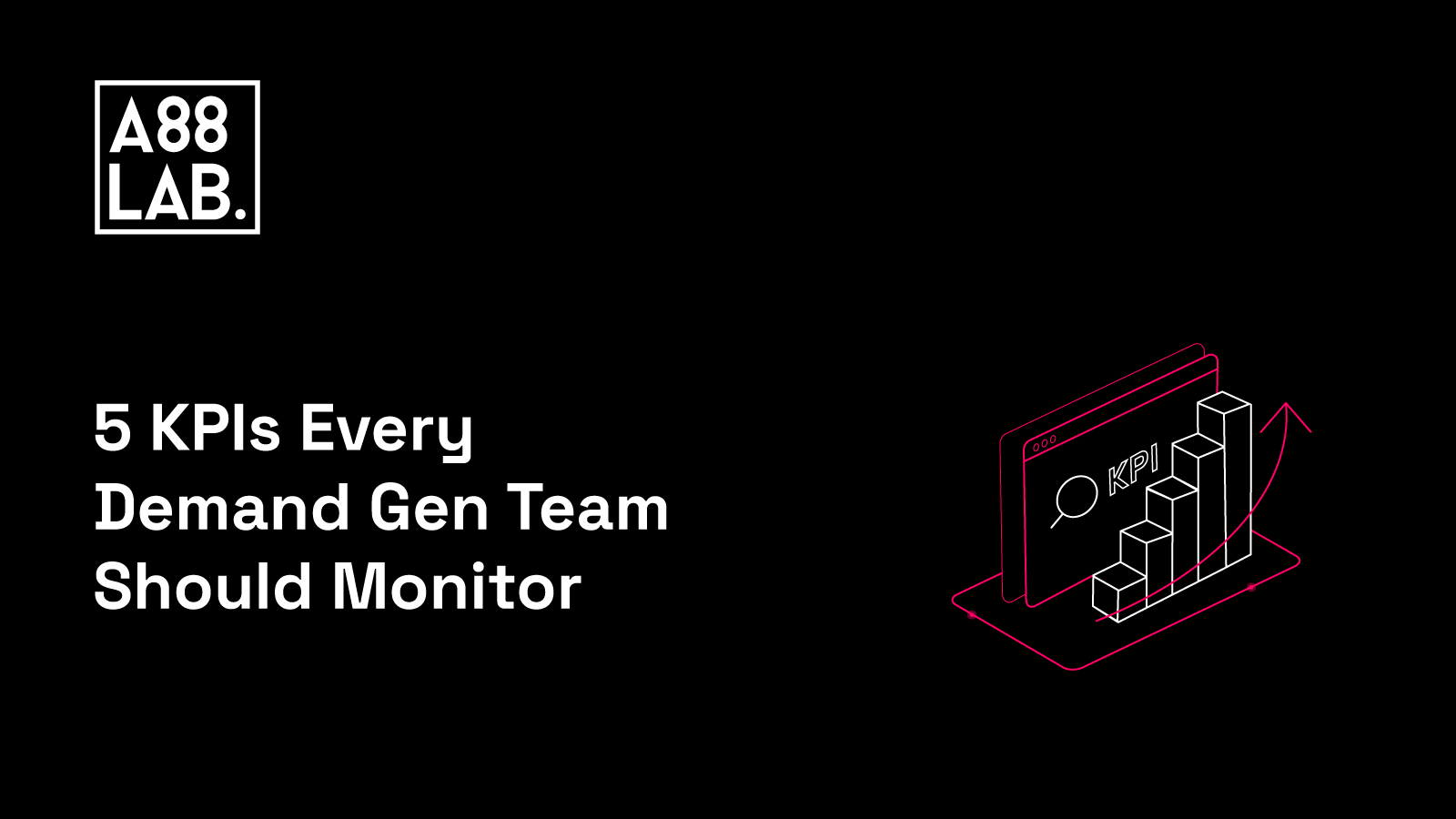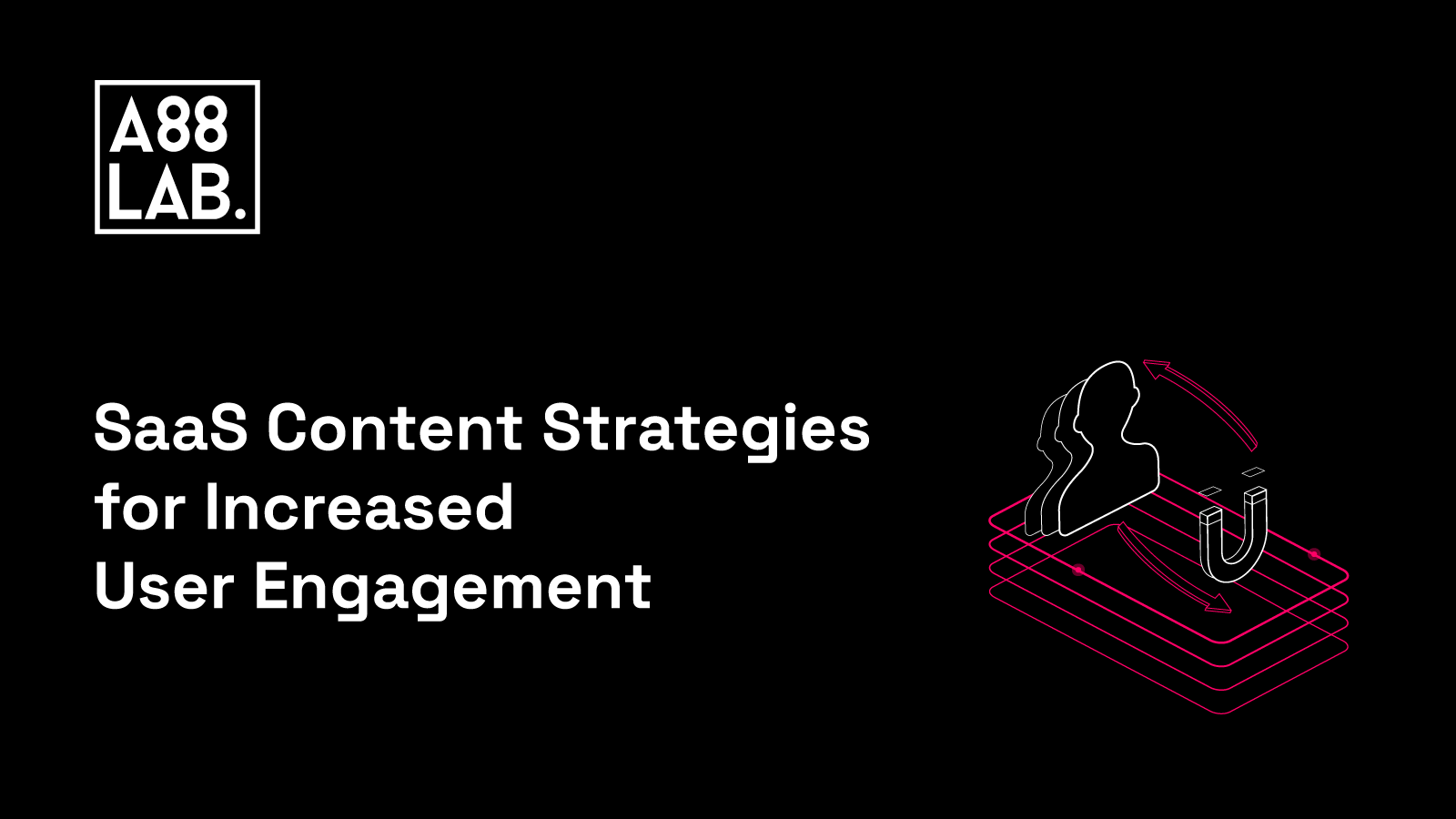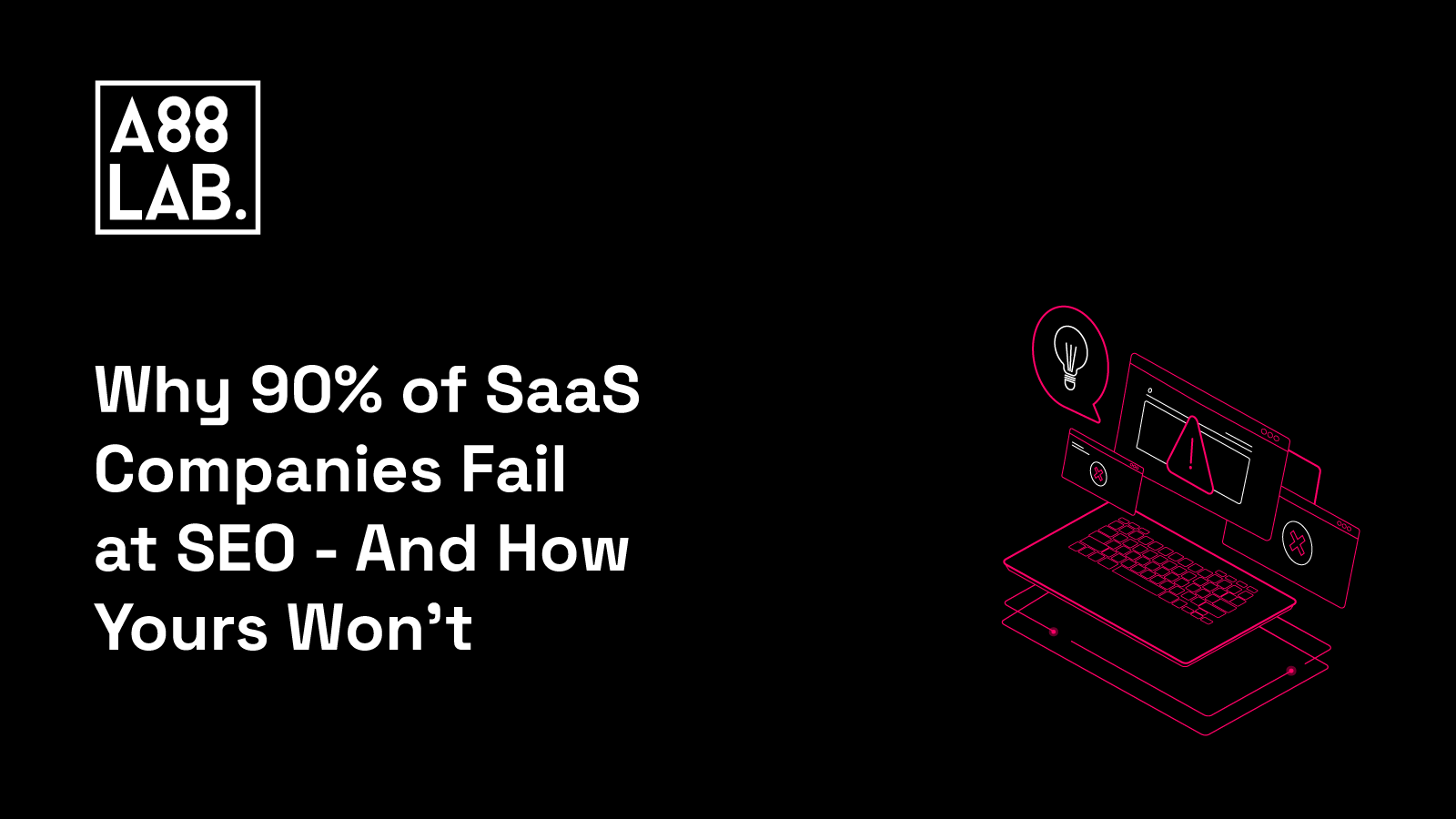If you're leading a SaaS marketing team, you know the importance of keeping tabs on your demand generation performance. To truly gauge its effectiveness, your demand gen team should focus on specific KPIs to understand what's working and what's not. Once you have a clear grasp of your strengths and weaknesses, you can fine-tune your strategy for success and tangible outcomes.
There are countless KPI metrics that can be measured out there, but it's not necessary to track all of them. Instead, focus on monitoring the right set of KPIs that provide valuable insights into the performance of your demand generation strategy.
If you’re still not sure what KPIs you should track, in this blog post, we'll discuss 5 essential KPIs that every demand gen team should keep an eye on, regardless of the SaaS industry or target audience.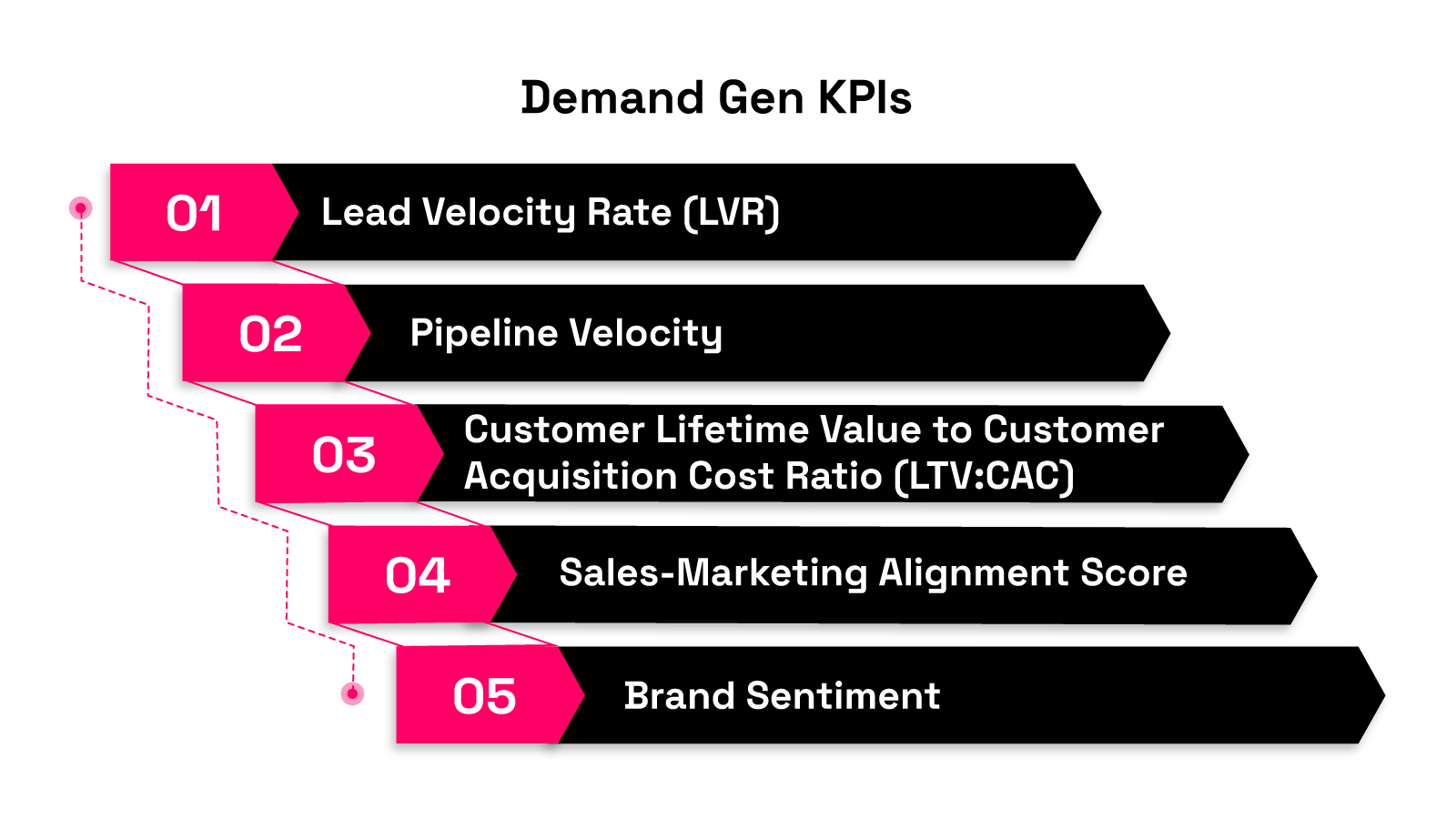
Lead Velocity Rate (LVR)
Lead Velocity Rate (LVR) is a powerful metric in demand generation that gives insights into the growth of your company. It goes beyond just looking at sales revenue or monthly recurring revenue. It tracks the number of qualified leads your company is generating each month, indicating the level of demand for your offerings.
Don't confuse LVR with pipeline velocity, though. While pipeline velocity measures how quickly deals move through your sales pipeline, LVR focuses on the growth potential based on the number of sales-qualified leads entering your sales funnel.
To calculate LVR, subtract the number of qualified leads last month from the number of qualified leads this month. Then divide by the number of qualified leads last month and multiply by 100 to get the percentage.
[ Qualified leads a current month - Qualified leads last month ] / Qualified leads last month X 100 = (%) Lead Velocity Rate
When it comes to measuring and analyzing LVR, here are a few important things to keep in mind:
-
It's crucial to have a reliable system of tools and steps in place to ensure lead quality. This will ensure accurate LVR calculations.
-
Consider calculating LVR alongside other key sales metrics, such as overall conversion rate, sales stage conversation rate, sales cycle length, MRR growth rate, CAC, and CLTV. Looking at these metrics together will provide a more comprehensive view of growth potential.
-
Remember that relying solely on LVR will only give you a partial understanding of the bigger growth picture.
LVR is a valuable metric that helps your demand gen team predict future revenues and optimize growth strategies. However, it's important to balance it with other growth metrics for better accuracy. By qualifying this metric with other relevant data, SaaS businesses can create a comprehensive and reliable growth strategy that enables them to achieve their goals effectively and efficiently.
Pipeline Velocity
Pipeline velocity, also known as sales velocity, is a demand generation KPI that measures how quickly opportunities move through your sales pipeline, from initial contact to closing the deal.
By analyzing pipeline velocity outcomes, you gain insight into the overall well-being of your SaaS enterprise, evaluate the performance of your sales team, and identify opportunities for improving sales productivity to reach your revenue targets.
Four essential factors to consider when calculating this metric are:
-
Number of Opportunities - To ensure a healthy bottom line, track the number and quality of opportunities in your sales pipeline. Focusing on qualified leads can help avoid wasted effort and resources.
-
Win/Conversion Rate - Your win/conversion rate is tied to the number of your quality leads. Track it to improve your sales process.
-
Deal Value (average deal size) - The most valuable resource of both parties, you and your prospect, is time. To maximize its use, introduce offers or add-ons to improve your prospect's life while increasing your average deal value and pipeline velocity.
-
Length of Sales Cycle (measured in months) - This is the only factor of the pipeline metric that you don't want to be increased. Achieve this by creating a more efficient sales process, redefining your sales playbook, and sometimes adding headcount to your sales team.
To figure out pipeline velocity, multiply the number of qualified opportunities in your pipeline by the average deal size for your sales team. Then, divide that number by the average time it takes for a sale to close.
Pipeline Velocity = Number of Opportunities x Deal Value x Win Rate / Length of Sales Cycle
Having high velocity means your leads face few or no hurdles in the onboarding process, which encourages them to convert faster. The more clients you onboard within a given time period, the more demand your SaaS generates.
Having a high velocity in converting leads into customers is just as important as generating a high volume of leads for your demand generation strategy. This indicates that your marketing and sales processes work together efficiently and achieve your SaaS goals.
Customer Lifetime Value to Customer Acquisition Cost Ratio (LTV: CAC)
Most of the revenue in your company comes from customers who want to do business with you. However, achieving this partnership requires possessing and implementing the right acquisition methods that can turn these partnerships into a profit. This is where comparing customer acquisition cost with lifetime value comes in.
Customer acquisition cost (CAC) shows how much your business spends on different campaigns in order to attract a new customer, while Lifetime Value (LTV) represents the average amount of revenue one single customer generates for the duration of their business with you.
While these metrics exist and can be implemented independently, they can also be used as a comparison. The ratio of LTV to CAC helps you determine how much you should be spending to acquire a customer and the lifetime of that customer. Calculating this ratio will show if you're spending too much per customer or if you're missing opportunities by not spending enough.
LTV: CAC Ratio Calculation:
LTV / CAC = LTV:CAC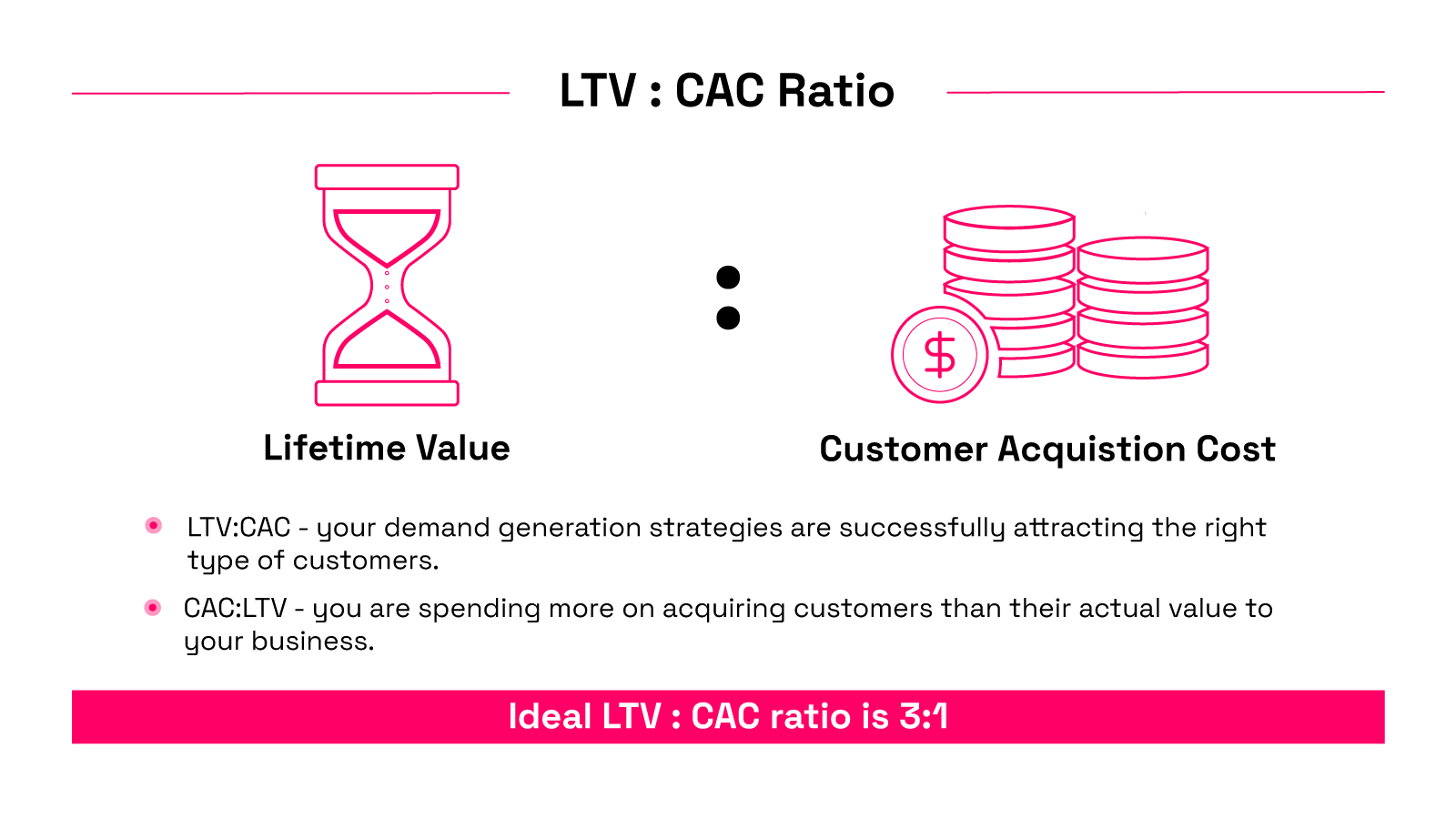 A high LTV: CAC ratio is a sign that your demand generation efforts are not only bringing in customers, but they are bringing in the right kind of customers—ones who stick around and keep adding value over time. It's an indicator of efficiency and profitability in your marketing and sales efforts.
A high LTV: CAC ratio is a sign that your demand generation efforts are not only bringing in customers, but they are bringing in the right kind of customers—ones who stick around and keep adding value over time. It's an indicator of efficiency and profitability in your marketing and sales efforts.
If your CAC outweighs the LTV, it's a red flag. You might be spending more to acquire customers than they're ultimately worth to your business.
Knowing your LTV: CAC ratio helps you allocate resources wisely. It guides you in optimizing your marketing strategies to attract customers with higher lifetime value, ensuring a sustainable and profitable customer base.
Sales-Marketing Alignment Score
Sales-Marketing Alignment Score is based on the lead scoring method, which ranks leads according to their value and readiness for sales and marketing purposes. By assigning scores or labels to various attributes such as company name, job title, country, and online behavior, the sales and marketing teams can work together to create an accurate and realistic scoring system that incorporates relevant attributes and behaviors for both teams.
Maintaining an open dialogue between the teams is crucial to ensuring that the Sales-Marketing Alignment Score remains an effective tool for demand generation. It allows the sales and marketing teams to work together to create a scoring system that accurately identifies leads that are ready to convert. By assigning scores or labels to various attributes and behaviors, both teams can ensure that they are targeting the right leads at the right time, resulting in increased conversions and revenue.
This alignment can lead to an average of 20% growth in annual revenue, making it a vital metric for SaaS businesses. The Lead Scoring Calculator is an essential tool for demand gen teams that helps create a customized roadmap that can turn chaos into a symphony.
Brand Sentiment
Last but certainly not least, the metric your demand gen team needs to monitor is brand sentiment. Brand sentiment is a process that analyzes customers' opinions about a brand.
Understanding the sentiment towards your SaaS brand is crucial for effective demand generation. By analyzing audience opinions, SaaS businesses can identify the factors that impact their perception of the brand and take appropriate actions to enhance the sentiment.
Real-time monitoring of sentiment can help prevent or reduce negative consequences of media coverage, campaigns, product launches, and other events. Improving brand sentiment can result in increased demand generation, higher customer loyalty, and better customer retention for SaaS companies.
By constantly keeping an eye on your brand sentiment, you'll be able to identify problems as soon as possible and respond quickly to the negative sentiment before it turns into something bigger.
If you successfully deliver branded content at the beginning of the customer journey, you should notice an improvement in how people feel about your brand over time.
There are various SaaS tools available to help you gather the feedback you need, just as there are tools for tracking content performance. For instance, you can use platforms like Typeform and VideoAsk to collect customer feedback. Alternatively, you could use a user research platform such as Maze to test how your brand sentiment resonates with your target demographic.
No matter which method you choose for your brand sentiment research, the crucial thing is that you're conducting it, learning from it, and using the insights to refine your content strategy upfront. This way, you can build stronger relationships with potential customers.
Maintaining a positive brand sentiment can also help you stand out in a crowded market. With so many competitors vying for attention, having a strong and positively perceived brand can make all the difference when it comes to attracting and retaining customers. By consistently delivering high-quality branded content and actively monitoring your brand sentiment, you are setting yourself apart from others in your industry.
The Importance of KPIs in Your Demand Generation Strategy
Using the right set of KPIs is essential for demand generation for various reasons:
-
They provide tangible metrics that measure the success of your efforts
-
Offer a clear picture of how well your strategies are performing
-
Help you to make informed data-driven decisions
- Identify areas for improvement in your demand generation strategy.
Moreover, KPIs help you assess whether your demand generation efforts are contributing to the overall objectives of the organization, such as increasing revenue, acquiring new customers, or expanding market share. By understanding which aspects of your demand generation strategy are most effective, you can allocate resources more efficiently, ensuring that your time, budget, and efforts are focused on the activities that deliver the highest return on investment.
By setting benchmarks and goals through KPIs, you create a framework for continuous improvement, enabling you to stay competitive and responsive to market changes. One more benefit the offer is serving as a common language for different teams within an organization, particularly between marketing and sales, fostering better communication and alignment of goals, ensuring that everyone is working towards shared objectives.
Overall, KPIs are the compass that guides your demand generation efforts, measuring past performance and informing future actions.
Conclusion
Monitoring and analyzing Demand Generation KPIs is a crucial part of any demand generation strategy. By effectively monitoring the most important KPIs like LVR, Pipeline Velocity, LTV: CAC, Sales-Marketing Alignment Score, and Brand Sentiment, you bring your SaaS business valuable insights that it can use to continue achieving success.
To maintain a competitive edge, it is crucial to continuously track, test, and refine your strategies based on these KPIs. By doing so, you can ensure that your demand-generation efforts are as effective as possible and that your SaaS business continues to succeed.
.png)
